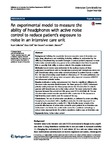An experimental model to measure the ability of headphones with active noise control to reduce patient's exposure to noise in an intensive care unit.
| dc.contributor.author | Gallacher, S | en |
| dc.contributor.author | Enki, D | en |
| dc.contributor.author | Stevens, S | en |
| dc.contributor.author | Bennett, MJ | en |
| dc.date.accessioned | 2017-12-11T09:14:13Z | |
| dc.date.available | 2017-12-11T09:14:13Z | |
| dc.date.issued | 2017-10-17 | en |
| dc.identifier.issn | 2197-425X | en |
| dc.identifier.uri | http://hdl.handle.net/10026.1/10397 | |
| dc.description.abstract |
BACKGROUND: Defining the association between excessive noise in intensive care units, sleep disturbance and morbidity, including delirium, is confounded by the difficulty of implementing successful strategies to reduce patient's exposure to noise. Active noise control devices may prove to be useful adjuncts but there is currently little to quantify their ability to reduce noise in this complex environment. METHODS: Sound meters were embedded in the auditory meatus of three polystyrene model heads with no headphones (control), with headphones alone and with headphones using active noise control and placed in patient bays in a cardiac ICU. Ten days of recording sound levels at a frequency of 1 Hz were performed, and the noise levels in each group were compared using repeated measures MANOVA and subsequent pairwise testing. RESULTS: Multivariate testing demonstrated that there is a significant difference in the mean noise exposure levels between the three groups (p < 0.001). Subsequent pairwise testing between the three groups shows that the reduction in noise is greatest with headphones and active noise control. The mean reduction in noise exposure between the control and this group over 24 h is 6.8 (0.66) dB. The use of active noise control was also associated with a reduction in the exposure to high-intensity sound events over the course of the day. CONCLUSIONS: The use of active noise cancellation, as delivered by noise-cancelling headphones, is associated with a significant reduction in noise exposure in our model of noise exposure in a cardiac ICU. This is the first study to look at the potential effectiveness of active noise control in adult patients in an intensive care environment and shows that active noise control is a candidate technology to reduce noise exposure levels the patients experience during stays on intensive care. | en |
| dc.format.extent | 47 - ? | en |
| dc.language | eng | en |
| dc.language.iso | eng | en |
| dc.subject | Active noise control | en |
| dc.subject | Noise | en |
| dc.title | An experimental model to measure the ability of headphones with active noise control to reduce patient's exposure to noise in an intensive care unit. | en |
| dc.type | Journal Article | |
| plymouth.author-url | https://www.ncbi.nlm.nih.gov/pubmed/29043462 | en |
| plymouth.issue | 1 | en |
| plymouth.volume | 5 | en |
| plymouth.publication-status | Published online | en |
| plymouth.journal | Intensive Care Med Exp | en |
| dc.identifier.doi | 10.1186/s40635-017-0162-1 | en |
| plymouth.organisational-group | /Plymouth | |
| plymouth.organisational-group | /Plymouth/REF 2021 Researchers by UoA | |
| plymouth.organisational-group | /Plymouth/REF 2021 Researchers by UoA/UoA03 Allied Health Professions, Dentistry, Nursing and Pharmacy | |
| plymouth.organisational-group | /Plymouth/Research Groups | |
| plymouth.organisational-group | /Plymouth/Research Groups/Institute of Health and Community | |
| plymouth.organisational-group | /Plymouth/Research Groups/Institute of Translational and Stratified Medicine (ITSMED) | |
| plymouth.organisational-group | /Plymouth/Research Groups/Institute of Translational and Stratified Medicine (ITSMED)/CBBB | |
| dc.publisher.place | Germany | en |
| dcterms.dateAccepted | 2017-10-09 | en |
| dc.rights.embargoperiod | Not known | en |
| rioxxterms.versionofrecord | 10.1186/s40635-017-0162-1 | en |
| rioxxterms.licenseref.uri | http://www.rioxx.net/licenses/all-rights-reserved | en |
| rioxxterms.licenseref.startdate | 2017-10-17 | en |
| rioxxterms.type | Journal Article/Review | en |


